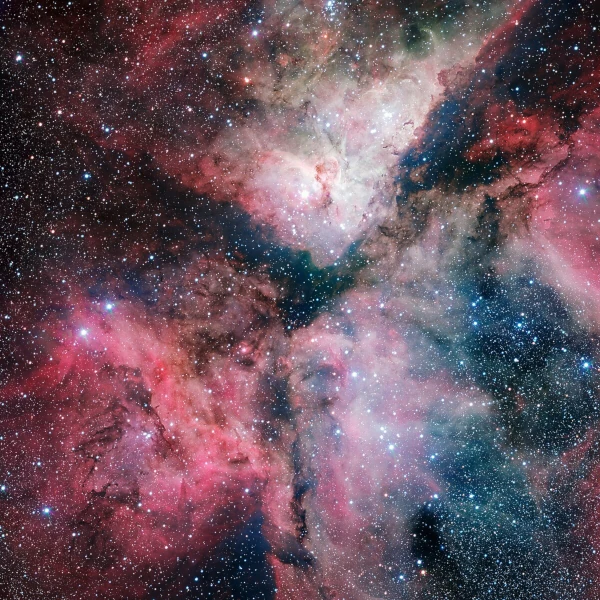
The Carina Nebula, also known as NGC 3372, is one of the largest star-forming regions in the Milky Way. Located about 7,500 light-years from Earth in the southern constellation Carina, this nebula emits spectacular light due to the energy released by its massive young stars. It spans over 300 light-years, making it an unparalleled cosmic laboratory for studying the birth, evolution, and death of stars.
Among its most remarkable objects is Eta Carinae, a hypermassive star system in its terminal phase, famous for its cataclysmic eruptions observed since the 19th century. The intensity of ultraviolet radiation and stellar winds generated by these giants constantly changes the structure of the giant molecular cloud, sculpting pillars, cavities, and shock waves where other stars are born.
Thanks to observations from the Hubble telescope and more recently the James Webb Space Telescope, astronomers have been able to probe the densest regions of the nebula, revealing proto-stars and protoplanetary disks. This data helps better understand the feedback cycles between massive stars and the interstellar medium, a crucial mechanism in regulating star formation on a galactic scale.
The table below presents the main physical characteristics of the Carina Nebula compared to other emblematic nebulae, highlighting its exceptional nature.
| Nebula | Distance (ly) | Dimensions | Massive Star(s) | Gas Temperature (K) |
|---|---|---|---|---|
| Carina (NGC 3372) | 7,500 | 300 ly | Eta Carinae | 10,000 – 12,000 |
| Orion (M42) | 1,344 | 24 ly | θ¹ Orionis C | 9,000 – 10,000 |
| Eagle (M16) | 5,700 | 70 ly | Wings Cluster | 7,000 – 9,000 |
| Lagoon (M8) | 4,000 | 110 ly | 9 Sagittarii | 7,500 – 8,500 |
| Trifid (M20) | 5,200 | 40 ly | HD 164492A | 8,000 – 10,000 |
| Rosette (NGC 2237) | 5,000 | 130 ly | NGC 2244 cluster | 6,000 – 8,000 |
| Horsehead (Barnard 33) | 1,375 | 5 ly | σ Orionis | ≈ 10 – 100 |
| California (NGC 1499) | 1,000 | 100 ly | Xi Persei | 8,000 |
| Heart (IC 1805) | 7,500 | 200 ly | Melotte 15 | 6,000 – 8,000 |
| Soul (IC 1848) | 7,500 | 150 ly | Westerlund 19 | 6,500 – 8,000 |
Sources: NASA Hubble Site, ESA/Hubble, JWST, ESO
Since 2022, the James Webb Space Telescope (JWST) has explored the Carina Nebula with unprecedented precision in the mid-infrared ($\lambda = 3-28 \ \mu\text{m}$). Thanks to its angular resolution of about $0.1''$ and thermal sensitivity, Webb has probed the internal structures of gas and dust columns—particularly the famous "Mystic Mountains"—revealing deeply embedded protostars and propagating ionization fronts.
These observations have highlighted forming protoplanetary disks, suggesting that the photoevaporative erosion effects induced by stellar winds are not sufficient to completely interrupt the accretion process. This challenges traditional models where UV radiation from OB stars would disperse gas too quickly to allow the formation of planetary systems.
Another recent discovery concerns the bipolar jets emanating from some forming protostars. These jets, collimated over several light-years, are revealed by hydrogen recombination lines ($\mathrm{H}\alpha$, $\mathrm{Br}\gamma$), as well as by the rotational lines of CO and H2. Their dynamics allow estimating accretion rates and the presence of locally intense magnetic fields ($B \sim 10^{-4}$ T), channeling matter around the stellar equator.
Magneto-hydrodynamic (MHD) models constrained by these observations suggest that the magnetic field plays a crucial role in the orientation of flows and in regulating the initial spin of newborn stars, beyond the local turbulence of the medium.
Finally, astronomers have observed new evidence of the evolutionary instability of Eta Carinae, a Luminous Blue Variable (LBV) type, on the verge of transitioning between a Wolf-Rayet star and an imminent supernova. Expanding shells of matter, emitted during the 1843 eruption, continue to cool through infrared emission and are mapped in the lines of Fe II and Si IV. Pre-supernova mass loss models indicate that a Type IIn supernova explosion could occur within the next few thousand years, leaving behind a nebula enriched with heavy elements such as calcium, iron, or titanium.